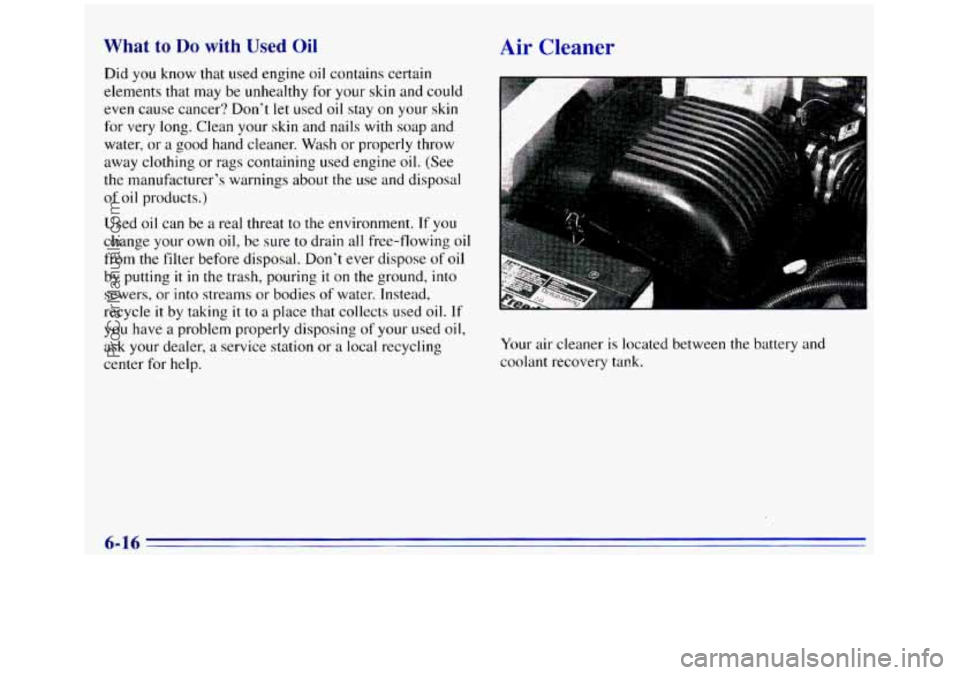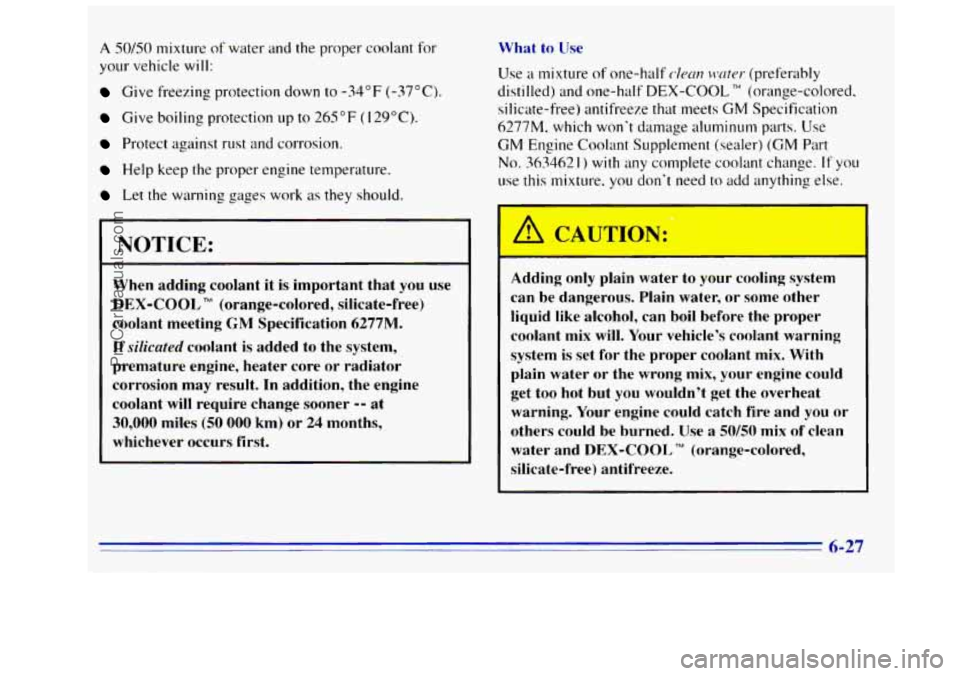Page 266 of 404

What to Do with Used Oil
Did you know that used engine oil contains certain
elements that
may be unhealthy for your skin and could
even cause cancer? Don’t let used
oil stay on your skin
for very long. Clean your skin and nails with soap and
water, or
a good hand cleaner. Wash or properly throw
away clothing or rags containing used engine oil. (See
the manufacturer’s warnings about the use and disposal
of oil products.)
Used
oil can be a real threat to the environment. If you
change your own
oil, be sure to drain all free-flowing oil
from the filter before disposal. Don’t ever dispose
of oil
by putting it in the trash, pouring it on the ground, into
sewers,
or into streams or bodies of water. Instead,
recycle
it by taking it to a place that collects used oil. If
you have a problem properly disposing of your used oil,
ask your dealer, a service station or a local recycling
center for
help.
Air Cleaner
Your air cleaner is located between the battery and
coolant recovery tank.
ProCarManuals.com
Page 276 of 404

Front Axle
When to Check and Change Lubricant
Refer to the Maintenance Schedule to determine how
often
to check the lubricant and when to change it. See
"Scheduled Maintenance Services"
in the Index.
How to Check Lubricant
If the level is below the bottom of the filler plug hole.
you'll
need to add some lubricant.
If the differential is at operating temperature (warm),
add enough lubricant
to raise the level to the bottom of
the filler plug hole.
If the differential is cold, add enough lubricant to raise
the level
to 1/2 inch (1 2 mm) below the filler plug hole.
What to Use
Refer to the Maintenance Schedule to determine what
kind
of lubricant to use. See "Recommended Fluids and
Lubricants"
in the Index.
Engine Coolant
The cooling system in your vehicle is filled with new
DEX-COOL
TM (orange-colored, silicate-free) engine
coolant. This coolant is designed
to remain in your
vehicle for
5 years or 100,000 miles (1 66 000 km),
whichever occurs first.
The following explains
your cooling system and how
to add coolant when it is low. If you have a problem
with engine overheating, see "Engine Overheating"
in
the Index.
6-26
ProCarManuals.com
Page 277 of 404

A 50/50 mixture of water and the proper coolant for
your vehicle
will:
Give freezing prorecrlon down to -34°F (-37°C).
Give boiling protection up to 265°F (129°C).
Protect against rust and corrosion.
Help keep the proper engine temperature.
Let the warning gages work as they should.
NOTICE:
When adding coolant it is important that you use
DEX-COOL TM (orange-colored, silicate-free)
coolant meeting
GM Specification 6277M.
If silicated coolant is added to the system,
premature engine, heater core or radiator
corrosion may result.
In addition, the engine
coolant will require change sooner
-- at
30,000 miles (50 000 km) or 24 months,
whichever occurs first. use
a mixture
of one-half dum wwter (preferably
distilled) and one-half
DEX-COOL” (orange-colored.
silicate-free) antifreeze that meets
GM Specification
6277M. which
won‘t damage aluminum parts. Use
GM Engine Coolant Supplement (sealer) (GM Part
No. 363462 1 ) with any complete coolant change. If you
use this mixture.
you don’t need to add anything else.
Adding only plain water to your cooling system
can be dangerous. Plain water, or some other
liquid like alcohol, can boil before the proper
coolant mix will. Your vehicle’s coolant warning
system
is set for the proper coolant mix. With
plain water or the wrong mix, your engine could
get
too hot but you wouldn’t get the overheat
warning. Your engine could catch fire and you or
others could be burned. Use a
50150 mix of clean
water and
DEX-COOL TM (orange-colored,
silicate-free) antifreeze.
f 27
ProCarManuals.com
Page 278 of 404
NOTICE:
If you use an improper coolant mix, your engine
could overheat and be badly damaged. The
repair cost wouldn't be covered by your
warranty.
Too much water in the mix can freeze
and crack the engine, radiator, heater core and
other parts.
If you have to add coolant more than four times 8 year,
have
your dealer check your cooling system.
NOTICE:
If you use the proper coolant, you don't have to
add extra inhibitors or additives which claim to
improve the system. These can be harmful.
Checking Coolant
If your vehicle has a diesel engine, see "Clwcking
Coolant"
in the Diesel Engine Supplement.
d
The coolant recovery tank is located on the passenger
side at the rear corner of the engine compartment.
When your engine
is cold, the coolant level should be at
the
COLD mark, or a little higher. When your engine is
warm. the level sho~~ld be up to the HOT mark, or a
little higher.
6-28
ProCarManuals.com
Page 279 of 404
Adding Coolant
If you need more coolant, add the proper mix ut tho
cYN-hnt Ix~c'olY!l'\: tmk.
A CAUTION:
\---- -
Turning the radiator pressure cap when the
engine and radiator are hot can allow steam
and scalding liquids to blow out and burn you
badly. With the coolant recovery tank, you will
almost never have to add coolant at the radiator. Never turn the radiator pressure cap
-- even a
little
-- when the engine and radiator are hot.
Add coolant mix at the recovery tank, but be careful not
to spill it.
/rl CAUTION:
r -4
You can be burned if you spill coolant on hot
engine parts. Coolant contains ethylene glycol,
and it will burn if the engine parts are hot
enough. Don't spill coolant on a hot engine.
ProCarManuals.com
Page 280 of 404
Radiator Pressure Cap
(Gasoline Engine)
The radiator pressure cap must be tightly installed with
the arrows on the cap lined LIP with the overflow tube on
the radiator filler neck.
NOTICE:
Your radiator cap is a 15 psi (105 kPa)
pressure-type cap and must be tightly installed
to prevent coolant
loss and possible engine
damage from overheating. Be sure the arrows
on the
cap line up with the overflow tube on the
radiator filler neck.
Thermostat
Engine coolant temperature is controlled by a thermostat
in the engine coolant system. The thermostat stops the
flow of coolant through the radiator until the coolant
reaches
a preset temperature.
When you replace your thermostat, an AC@ thermostat
is recommended.
6-30
ProCarManuals.com
Page 320 of 404
014
020
03
09
0 l5
0.
04
0
0
l6
0 22
Fuse Usage
1
2
Stop/TCC Switch, Buzzer, CHMSL, Hazard
Lamps, Stoplamps
Transfer Case
3 Courtesy Lamps, Cargo Lamp, Glove
Box
Lamp, Dome/Reading Lamps, Vanity Mirrors,
Power Mirrors
Fuse
4
10
11
12
13
14
Usage
Instrument Cluster, DRL Relay, Lamp
Switch, Keyless
Entry, Low Coolant
Module, Illuminated Entry Module, DRAC
(Diesel Engine)
Not Used
Cruise Control
Auxiliary Power Outlet
Air Bag System
License Lamp, Parking Lamps, Taillamps, Roof Marker Lamps, Tailgate Lamps, Front
Sidemarkers, Fog Lamp Relay, Door Switch
Illumination, Fender Lamps, Headlamp
Switch Illumination
Air Bag System
Wiper Motor, Washer Pump
A/C, A/C Blower, High Blower Relay
Power Amp, Cigarette Lighter, Door Lock
Relay, Power Lumbar Seat
'
4WD Indicator, Cluster, Comfort Controls,
Instrument Switches, Radio Illumination,
Chime Module
6-70
ProCarManuals.com
Page 354 of 404

I Short TripKity Maintenance Schedule -- Gasoline Engines 1
100,000 Miles (166 000 km)
Drain, flush and refill cooling system (or
every
60 months since last service, whichever
occurs
first). See "Engine. Coolant" in the
Index for what to use. Inspect hoses. Clean
radiator, condenser, pressure cap and neck.
Pressure test cooling system and pressure cap.
An Emission Control Service.
0 Inspect spark plug wires.
Replace spark plugs. An Emission Contd Service.
0 Change automatic transmission fluid
and filter
if the vehicle's GVWR is over
8600 Ibs. or if the vehicle is mainly driven
under one
or more of these conditions:
- In heavy city traffic where the outside
temperature regularly reaches
90" F
(32 * C) or higher.
An Emission Control Service.
- In hilly or mountainous terrain.
- When doing frequent trailer towing.
- Uses such as found in taxi, police or
delivery service.
If' .e you c/o rzot LLW your vehicle under crny of
these corzciitiorzs, the.fluid and filter do not
require chcrnging.
Manual transmission fluid doesn't require change.
0 Inspect Positive Crankcase Ventilation
(Pcv) valve.
An Emission Control Service.
DATE SERVICED BY ACTUAL
MILEAGE
7-28
ProCarManuals.com